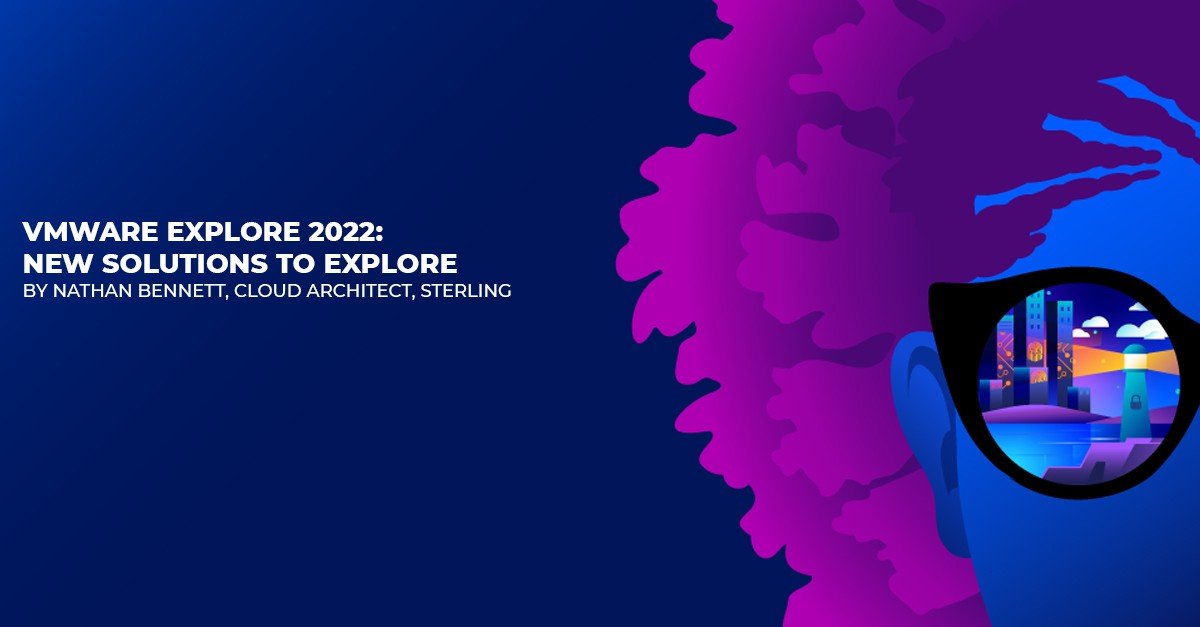By Nathan Bennett, Cloud Architect, Sterling
As I said in my blogpost last week ( https://bit.ly/3cy3adA ), I was fortunate to attend some pre-Explore 2022 webinars and hear the announcements that VMware was going to make around their new compute, storage, networking, and cloud offerings. If you tune in to VMware’s newsfeed, https://news.vmware.com/ , you’ll find in-depth information on these.
Besides unveiling their new conference name, VMware declared that Explore 2022 was going to be “the premiere multi-cloud event.” That piqued my interest. VMware already has multiple solutions in the clouds — including VMware software-defined data centers (SDDC) in every public cloud, allowing users to easily move workloads from their on-premises data centers into the clouds. So, what could be next? Here’s some of what I took away:
New in VMware Cloud (VMC) solutions:
- FSx with NetApp ONTAP integration, which will allow NFS connections directly into VMC on AWS solutions.
- VMware Flex Storage integration, featuring additional scalable storage external of VMC on AWS, to be connected and utilized as an NFS storage solution.
- VMware Flex Compute [in preview for select customers], which will allow smaller utilization of VMC on AWS by allowing a virtual machine to be deployed instead of a full SDDC cluster.
New In VMware Cloud Disaster Recovery (VCDR):
- VMware Cloud DR Ransomware Recovery
- Ransomware recovery allowing AI/ML to validate backup assets so that discovery of good data points for recovery is already available before users must repeat processes to find a good recovery point
- Follows same systems as VCDR, allowing an Incident Recovery Environment (IRE) separate from the production environment
- Ability to piecemeal individual data points so that a virtual machine can be recovered, allowing different recovery points to be utilized to build the VM, instead of an “all or nothing” approach to the restoration
New In VMware Cloud Management:
- VMware Aria —a cloud-management product combining operations and cost management for the multi-cloud world, https://www.vmware.com/products/aria.html
All these solutions are much welcome and not a moment too soon.
Currently, if you were to need more storage in VMC on AWS, you’d have to expand the compute hosts, because they only utilize local storage on each host for vSAN — or, optionally, you’d have to consume native cloud services such as S3 or Azure Blob. By allowing storage to be consumed outside of native public-cloud solutions, VMware and their partners can keep their data and consumption of data on a third-party solution that allows multiple integrations as provided. Customers can scale independently between the SDDC’s compute and the storage they want to connect to externally.
VCDR’s solutions around cybercrime are also arriving none too soon. Ransomware has become so prevalent a problem in the IT industry that the question is no longer if you will be cyberattacked, but when. (That is no cliché.) Numerous data signatures out there speak to just how lucrative ransomware is — that is, on a scale unknown before. So, an end-user’s being able to repair to an air-gapped environment or safe area makes sense, and that is how the response to ransomware is normally performed. Each step defined in this process follows the normal steps needed to recover. The truly next-gen part of the restoration is that ability to piecemeal the VM and pull different layers from the restore points to validate the best recovery. AI/ML anomaly-detection is already utilized for monitoring, in products such as vROPS. It’s no leap to see something like this used for validating and verifying restorations of workloads.
There has been some talk that VMware Aria is simply a rebranding of the vRealize suite combined with CloudHealth, Universal Licensing, and Skyline. Together they make for a formidable solution, which, however, could be pricey. But each component is vital to the success of the customer’s cloud journey. Being able to access self-service, automation, management, and support may be a benefit that customers not only consume but consume heavily, despite the hefty price tag.
All in all, these are great solutions to add to multi-cloud environments. VMC on AWS is the premiere VMware SDDC, so all new solutions will end up utilizing that area. Eventually, it will be expanded to other clouds and other areas.

